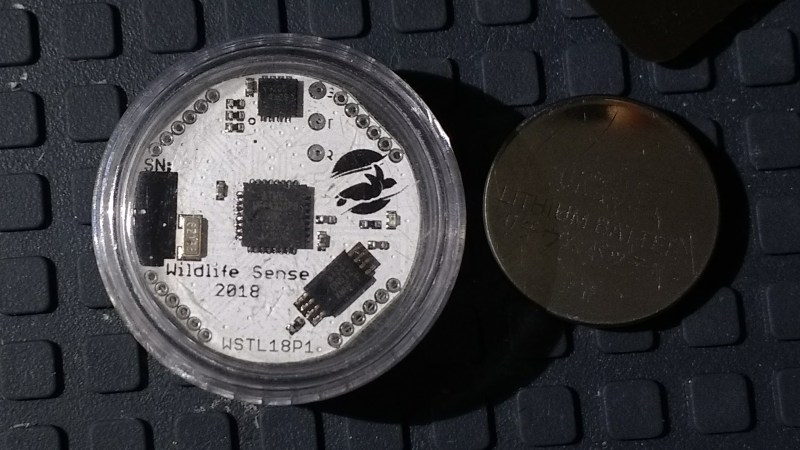Hacking and tinkering are always fun and games, but one just has to appreciate when all efforts are additionally aimed towards doing something good. [Nikos] sets an example by combining his interest in technology with his passion for wildlife conservation by creating a low cost and ultra-low power temperature logger — and he is using a coin cell for it.
As the founder of a sea turtle conservation project in Greece, [Nikos] enjoys building scientific instruments that help him and his team on their mission. With a goal to log the temperature every 10 minutes over a period of at least 180 days, he designed a PCB just big enough to hold a CR2032 coin cell. Fifty of them will eventually be sealed in waterproof enclosures, and buried in the sand for the whole research duration.
Limiting the design to its bare necessities, the rest of the PCB is housing a digital temperature sensor, an SPI EEPROM to hold all the recorded sensor values over those 180 days, and an ATmega328PB clocked by a 32.768kHz crystal. Wondering what to do with all the extra, unused pins of the ATmega, [Nikos] simply routed them to be accessible through pin headers, thus turning the data logger alternatively into a coin cell powered development board.
Assuming your logging interval requirements are significantly lower, you might be thrilled to hear that [Nikos] estimates a theoretical 7+ years an average coin cell could power the data logger in sleep mode, which makes him confident to reach the 180 days goal.

















I’m not sure why this is on Hackaday
I googled “waterproof data logger temperature” and there are loads of small products which already do this
e.g.
http://www.onsetcomp.com/products/data-loggers/mx2204
“But I can pay money for the same thing!”
Er, what are you doing here?
Actually, I have made something similar myself, but it uses the nRF51822QFAA BLE processor.
The sensors have been running for well over a year on 800mAH CR2477 button cells
Very interesting, are you able to control and get data over Bluetooth? Very cool battery!
In theory, the data from the board could be fetched over BLE, but I didnt have time to write the Android App to fetch the data, because I had issues Cordova BLE not working on different mobile phone and different versions of Android.
I tried several different Cordova BLE plugins, but none of them seemed to work very well when it came to connecting via a BLE service to the datalogger.
I have now started to look at using an ESP32 instead as the data logging component, as all the thermometers are located at various places around my house and garden, so would all be in range of the ESP32.
Using the ESP32 I can run a web server to view the logs and transfer them to a DB on the Internet if I wanted to.
(I’m likely to use my own PHP pages and DB, as I already have this for direct logging via an ESP8266)
A majority of ‘find my keys’ tags and a number of sports bands use nRF51s, depending on the firmware you’ll get 12-18 months at the top end for the tags (6 months if you’re unlucky) and 5-7 days on the sports bands.
rogerclarkmelbourne,
I am following your same footsteps but struggled to design a programmer with nRF51, do you mind sharing your project?
Thanks,
Fahd
The project isn’t really in a fit state to share.
I’m also not sure which bit of the project you are talking about.
Do you mean the hardware design of the nRF51, e.g. schematic and PCB.
Or the firmware running on the nRF51 (its written using the Nordic SDK using their API i.e not Arduino etc)
Or the Android App written in Cordova
You also say “Struggled to design a programmer”. I didn’t design a programmer, I used the BlackMagic probe to physically program the nRF51
I thought your designed your own programmer, thanks for the tip about the Black Magic Probe. $60 is some serious money, so I am looking for alternatives such as the DAPLink V1.5 by RedBear.
Cheap STLINK/V2 clones work perfectly for me with the nRF51s (like this: https://www.ebay.co.uk/itm/162766631259 | https://www.amazon.co.uk/dp/B0744QC542 )
I did build a BlackMagic probe using a generic STM32F103C8 development board.
But its just a question of loading the firmware and soldering the wires.
And like @opless says, you can use a STLink (using OpenOCD), and there is also a build of BlackMagic probe for STLink dongles
And what a steal at 30x the price! -_-
I had a similar project a couple years back except it was for a different application – medical. I chose to go with FRAM instead of flash as the power consumption is much less (about an order of magnitude) and the destructive read-rewrite problem is practically non-existent as, during deployment, you are only writing. At home base, I could read and charge the device at the same time wirelessly using a hacked form of the Qi charging specification. This method also served to maintain the airtight seal and thus the device would never have to be opened up.
Winner!
Am partial to FRAM myself. Folks should take another look at it.
There was deal with MSP430FR2433 LaunchPad for $4.99, now it’s $10 for micro with 16K fram
FRAM is cool but I had a quick look at mouser for a 512kbit FRAM and it was listed at €11.04 each. I’m buying these EEPROM chips for just over €0.20 each. Write cycles aren’t a problem as they’ll do one write session per 2-6 months. Ideally the PCB should have a generic footprint and each maker can select which memory chip they’ll use.
Agreed, especially when manufacturer have a range of low power MCU with quite large FRAM. Getting the data out wirelessly could be a challenge though. (Uart over IR led as the DMM do?)
UART over IR sounds interesting, any ideas on how to trigger that without affecting BOM and power consumption much?